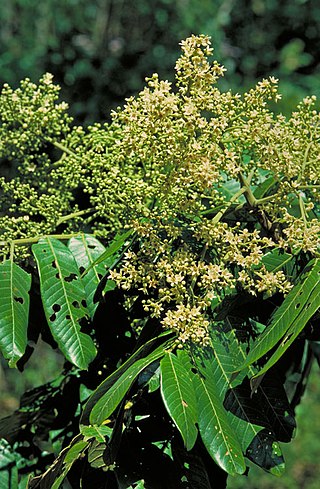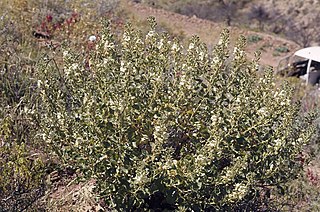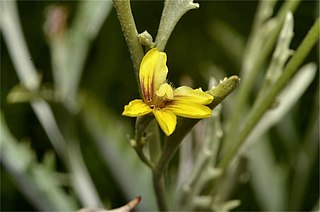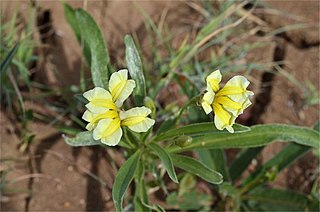
Flindersia ifflana, commonly known as hickory ash or Cairns hickory, is a species of tree in the family Rutaceae and is native to Papua New Guinea and Queensland. It has pinnate leaves with between four and twelve egg-shaped to elliptical leaflets, panicles of white or cream-coloured flowers and woody fruit studded with rough points.

Flindersia schottiana, commonly known as bumpy ash, cudgerie or silver ash, is a species of rainforest tree in the family Rutaceae and is native to New Guinea and eastern Australia. It has pinnate leaves with mostly ten to sixteen leaflets, panicles of white flowers and woody fruit studded with rough points.

Flindersia brayleyana, commonly known as Queensland maple, maple silkwood or red beech, is a species of tree in the family Rutaceae and is endemic to northern Queensland. It has pinnate leaves with between six and ten leaflets, panicles of white or cream-coloured flowers and smooth fruit that opens in five sections to release winged seeds.

Karrabina benthamiana is a species of rainforest trees, growing naturally in north–eastern New South Wales and south–eastern Queensland, Australia. They have common names including red carabeen, leather jacket, brush mahogany, red bean, pink marara and brush mararie. This species used to be placed in the genus Geissois as Geissois benthamiana.

Callerya is a genus of flowering plants in the legume family, Fabaceae. It belongs to the subfamily Faboideae, tribe Wisterieae. Its species are climbers, generally reaching up to about 1 m (3 ft) tall. The genus has a somewhat complicated taxonomic history; its circumscription was substantially revised in 2019.

Goodenia macmillanii, commonly known as pinnate goodenia, is a species of flowering plant in the family Goodeniaceae and is endemic to Victoria, Australia. It is an erect, short-lived perennial shrub with lyrate or lobed leaves, egg-shaped to elliptic in outline with toothed edges, and leafy racemes of bluish-purple flowers.

Aristolochia praevenosa, synonym Pararistolochia praevenosa, is an Australian plant in the birthwort family, native to Queensland and New South Wales. The Richmond birdwing butterfly vine grows in subtropical rainforest in coastal areas north from Wollongbar, in far north eastern New South Wales and adjacent areas in south eastern Queensland. It has been recorded as far north as the Mary River. It also grows in tropical north eastern Queensland, where it is a food plant for the Cairns birdwing butterfly.

Vesselowskya rubifolia, commonly known as southern marara, red ash, mountain marara or Dorrigo southern marara, is a species of flowering plant in the family Cunoniaceae plant and has a restricted distribution in eastern New South Wales. It is a shrub or small tree with compound leaves with three or five leaflets with serrated edges, and small whitish flowers arranged along a raceme.
Stenocarpus acacioides is a species of flowering plant in the family Proteaceae and is endemic to north-western Australia. It is a shrub or tree with elliptic leaves and groups of white flowers and woody, linear follicles.

Bouchardatia neurococca, commonly known as union nut, is a species of small rainforest tree that is endemic to eastern Australia. It has pinnate leaves with three or five narrow elliptical leaflets, white flowers arranged in panicles, and oval follicles.

Goodenia armitiana, commonly known as narrow-leaved goodenia or fine goodenia, is a species of flowering plant in the family Goodeniaceae and is endemic to northern Australia. It is an erect herb with sticky or vanished cylindrical leaves, racemes of yellow flowers with leaf-like bracts at the base, and more or less spherical fruit.

Goodenia chambersii is a species of flowering plant in the family Goodeniaceae and is endemic to South Australia. It is an ascending shrub with toothed, broadly egg-shaped to round leaves, racemes or thyrses of yellow flowers and oval fruit.

Goodenia disperma is a species of flowering plant in the family Goodeniaceae and is endemic to Queensland. It is an erect undershrub with linear leaves on the stem, and racemes of white flowers.
Goodenia macroplectra is a species of flowering plant in the family Goodeniaceae and is endemic to inland Western Australia. It an erect herb with toothed, lance-shaped leaves at the base of the plant, and racemes of dark yellow flowers with a long spur.

Goodenia microptera is a species of flowering plant in the family Goodeniaceae and is endemic to the Pilbara region of Western Australia. It is an erect to ascending, sprawling herb with narrow oblong to lance-shaped leaves sometimes with teeth on the edges, and racemes of yellow flowers with a brownish centre.

Goodenia mueckeana is a species of flowering plant in the family Goodeniaceae and is endemic to central Australia. It is an ascending, perennial herb with toothed, linear to egg-shaped leaves and racemes or thyrses of yellow flowers.

Goodenia strangfordii, commonly known as wide-leaved goodenia in the Northern Territory, is a species of flowering plant in the family Goodeniaceae and is endemic to northern Australia. It is an erect herb with narrow elliptic to lance-shaped stem leaves with the narrower end towards the base, and racemes of yellow flowers.
Gompholobium gompholobioides is a species of flowering plant in the family Fabaceae and is endemic to the south-west of Western Australia. It is a spreading shrub with pinnate leaves and uniformly yellow, pea-like flowers.

Wisterieae is a tribe of flowering plants in the bean family Fabaceae. The tribe was first described in 1994 for the sole genus Wisteria, but was greatly expanded in 2019 to include 13 genera, six of which were new. Five had previously been placed in the tribe Millettieae. Members of the tribe are climbers of various kinds. Some, like Wisteria, are cultivated for their flowers.

Austrocallerya australis, commonly known as native wisteria, blunt wisteria or Samson's sinew in Australia, is a species of flowering plant in the family Fabaceae, native to north-eastern Australia, New Guinea and some Pacific Islands. It is a tall, woody climber with pinnate leaves, the leaflets oblong, elliptic or egg-shaped, and panicles of purple, pea-like flowers.


















